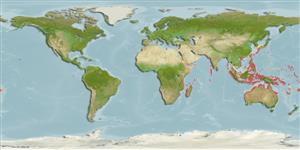Ulvophyceae |
Dasycladales |
Dasycladaceae
Environment: milieu / climate zone / depth range / distribution range
Ecology
Sessile; depth range 0 - 3 m (Ref. 102136). Tropical
Indian Ocean: Tanzania to Madagascar, east to Singapore and south to Dampier Western Australia; Pacific Ocean: from China to Queensland, Australia, including Japan, Vietnam, Philippines, Papua New Guinea, Federated States of Micronesia and Fiji.
Length at first maturity / Size / Weight / Age
Maturity: Lm ? range ? - ? cm
Thallus green to brownish red, usually bent, club-shaped, attached to substrate by a small rhizoidal holdfast. Cross section of thallus shows a cylindrical axial filament extending almost the whole length of the thallus. Successive whorls of lateral branches cover the thallus, each whorl consisting of 24 to 28 primary lateral branches, slightly expanded at their distal ends and giving rise to 4 to 7 short capitate branchlets laterally coherent forming a monostromatic cortex. Cortical cells polygonal in surface view. Each primary lateral branch with 4 or more aplanosporangia, 150 to 190 μm in diameter and containing 2 to 9 oval or spherical aplanospores, 70 to 80 μm in diameter. Thallus up to 5 cm in height (Ref. 80758).
Grows in colonies on solid or rocky substrate in mid-tidal to low intertidal areas (Ref. 80758).
Life cycle and mating behavior
Maturity | Reproduction | Spawning | Eggs | Fecundity | Larvae
Guiry, M.D. and G.M. Guiry. 2009. (Ref. 80701)
IUCN Red List Status (Ref. 130435)
CITES status (Ref. 108899)
Not Evaluated
Not Evaluated
Threat to humans
Human uses
| FishSource |
Tools
More information
Age/SizeGrowthLength-weightLength-lengthMorphologyLarvaeAbundance
Internet sources
Estimates based on models
Preferred temperature
(Ref.
115969): 23.3 - 29.3, mean 28.5 (based on 2825 cells).
